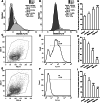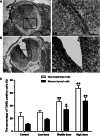Vinyl chloride monomer (VCM) induces high occurrence of neural tube defects in embryonic mouse brain during neurulation
- PMID: 24664314
- PMCID: PMC11488873
- DOI: 10.1007/s10571-014-0049-6
Vinyl chloride monomer (VCM) induces high occurrence of neural tube defects in embryonic mouse brain during neurulation
Abstract
The aim of this study was to explore the direct embryonic teratogenicity of vinyl chloride monomer (VCM), especially the toxic effects on the early development of the nervous system and its underlying mechanisms. Pregnant mice at embryonic day 6.5 (E6.5) were injected with different doses of VCM (200, 400 and 600 mg/kg) and embryos were harvested at E10.5. Our results showed that doses higher than 400 mg/kg of VCM increased the incidence of malformed embryos, especially the neural tube defects (NTDs). In addition, high-dose of VCM decreased mitotic figure counts in the neuroepithelium and enhanced the percentage of cells in G0/G1 phase, while they were reduced in S phase. The more VCM was injected into mice, the fewer positive PCNA cells were seen and the more positive TUNEL cells were observed in the neuroepithelium. Moreover, significant increases in the levels of caspase-3 protein were observed in NTD embryos. Our results demonstrate that during early pregnancy, exposure to doses higher than 400 mg/kg of VCM increases the incidence of malformations and particularly the rate of NTDs. High-dose of VCM inhibits the proliferation of neural cells and induces cell apoptosis, leading to an imbalance in the ratio of proliferation and apoptosis. Meanwhile, the apoptosis of neuroepithelial cells might be accelerated by the activation of the caspase-3 pathway, and it might be a reason for NTDs.
Conflict of interest statement
We declare that we have no conflict of interest.
Figures






Similar articles
-
Cycloleucine induces neural tube defects by reducing Pax3 expression and impairing the balance of proliferation and apoptosis in early neurulation.Neurochem Int. 2024 Nov;180:105861. doi: 10.1016/j.neuint.2024.105861. Epub 2024 Sep 20. Neurochem Int. 2024. PMID: 39307459
-
Deficiency of the oxidative stress-responsive kinase p70S6K1 restores autophagy and ameliorates neural tube defects in diabetic embryopathy.Am J Obstet Gynecol. 2020 Nov;223(5):753.e1-753.e14. doi: 10.1016/j.ajog.2020.05.015. Epub 2020 May 13. Am J Obstet Gynecol. 2020. PMID: 32416155 Free PMC article.
-
Role of methotrexate exposure in apoptosis and proliferation during early neurulation.J Appl Toxicol. 2014 Aug;34(8):862-9. doi: 10.1002/jat.2901. Epub 2013 Jul 9. J Appl Toxicol. 2014. PMID: 23836430
-
Apparent lability of neural tube closure in laboratory animals and humans.Am J Med Genet. 1999 Nov 19;87(2):143-62. doi: 10.1002/(sici)1096-8628(19991119)87:2<143::aid-ajmg6>3.0.co;2-j. Am J Med Genet. 1999. PMID: 10533029 Review.
-
Genetic backgrounds and modifier genes of NTD mouse models: An opportunity for greater understanding of the multifactorial etiology of neural tube defects.Birth Defects Res. 2017 Jan 30;109(2):140-152. doi: 10.1002/bdra.23554. Birth Defects Res. 2017. PMID: 27768235 Review.
Cited by
-
Induction of Fibrosis and Autophagy in Kidney Cells by Vinyl Chloride.Cells. 2019 Jun 17;8(6):601. doi: 10.3390/cells8060601. Cells. 2019. PMID: 31212930 Free PMC article.
References
Publication types
MeSH terms
Substances
LinkOut - more resources
Full Text Sources
Other Literature Sources
Medical
Research Materials
Miscellaneous

